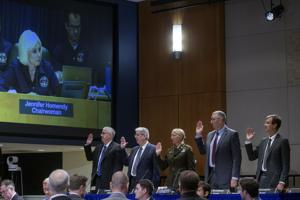A recent fact-finding hearing by the National Transportation Safety Board has brought to light critical factors contributing to a fatal midair collision between an Army helicopter and a commercial airliner. The inquiry underscores long-standing concerns about military helicopter routes in crowded airspace and worries over staffing shortages within federal aviation agencies, raising serious questions about overall aviation safety.
For years, experts have voiced apprehension regarding the intricate challenge of integrating military aircraft operations, particularly helicopters, into densely populated civilian flight corridors. The inherent complexities of disparate flight characteristics and operational mandates increase the potential for a catastrophic midair collision, a risk that the current investigation is meticulously examining.
Adding to these complexities are significant concerns surrounding short FAA staffing levels among federal aviation workers. A depleted workforce directly impacts the efficacy of air traffic control services, potentially leading to increased workload for controllers and reduced oversight, which can compromise the stringent safety protocols vital for preventing aerial incidents.
During the pivotal NTSB investigation hearing, key witnesses provided crucial insights into the accident. Representatives from Sikorsky Aircraft, the Federal Aviation Administration, and the U.S. Army offered detailed testimonies, shedding light on operational procedures and communication protocols in the moments leading up to the crash.
The National Transportation Safety Board’s methodical approach aims to uncover every contributing factor, ensuring a comprehensive understanding of the incident. This thorough examination is essential not only for assigning accountability but also for formulating precise recommendations to enhance safety standards across all sectors, especially within shared military airspace.
The findings from this high-profile inquiry carry profound implications for national aviation policy and regulatory frameworks. They highlight the urgent need for robust, proactive measures to address systemic vulnerabilities, ranging from flight corridor management to personnel allocation within critical safety agencies.
Moving forward, the NTSB’s final report is anticipated to outline concrete recommendations for both military and civilian aviation authorities. These measures are expected to focus on improving interoperability, refining training programs, and implementing technological upgrades to mitigate risks and prevent future accidents.
Ultimately, the outcome of this investigation will play a crucial role in reinforcing public confidence in the nation’s air transportation system. It serves as a stark reminder of the continuous vigilance required to maintain the highest possible standards of safety and efficiency in our skies, ensuring both civilian and military operations can coexist securely.






Leave a Reply